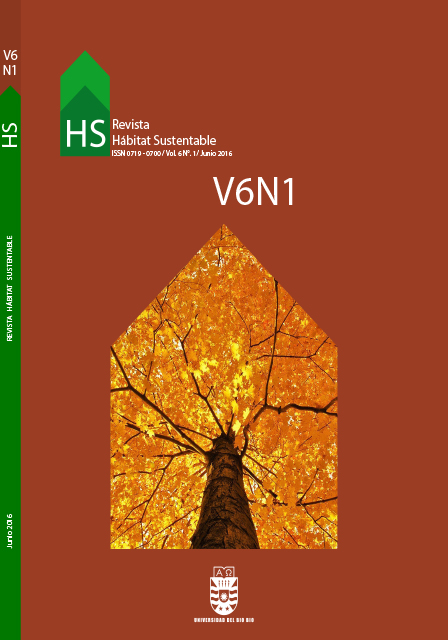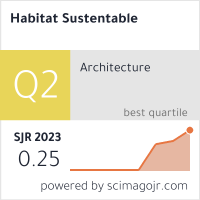Potencial solar activo en techumbres de viviendas inmobiliarias
DOI:
https://doi.org/10.22320/07190700.2016.06.01.05Palabras clave:
vivienda unifamiliar, integración arquitectónica térmica fotovoltaica, potencial solar, techumbre, integración arquitectónica térmica fotovoltaicaResumen
El presente artículo analiza las características geométricas de las techumbres de viviendas unifamiliares pertenecientes a conjuntos inmobiliarios recientes en Concepción (Chile) y su potencial de captación solar. Para ello, se ejecuta un registro de 2.139 casas construidas posteriores al año 2006, correspondientes a 68,3% del total. Al describir las cubiertas existentes, se detecta una superficie media de techumbre inclinada de 84,7 m2 y fragmentada, entre 3 y 12 alas o faldones, con inclinación media de 37,48°, que generan al menos un ala mayor o secundaria con superficie promedio de 33,9 m2 orientada al norte, este u oeste. Esta superficie recibe una radiación anual total de entre 954 kWha/m2 a 1.732,8 kWha/m2, según azimut e inclinación, lo que con paneles fotovoltaicos integrados produce potencialmente una media de 6.317,4 kWha. Además, se estudian casos extremos acorde a máxima y mínima superficie captadora por superficie construida, demostrando que la producción energética alcanzaría a abastecer eléctricamente con la tecnología fotovoltaica (PV) integrada. Finalmente, se evalúa el potencial de la tecnología híbrida térmica-fotovoltaica con fluido calotransportador de aire (PVTa).
Descargas
Citas
ASTEA, Niccolò; DEL PEROA, Claudio y LEONFORTEA, Fabrizio. Optimization of solar thermal fraction in PVT systems. Energy Procedia [en línea], 2012, vol. 30, pp. 8–18. [Consultado 15 mayo 2016]. DOI 10.1016/j.egypro.2012.11.003.
CÁMARA CHILENA DE LA CONSTRUCCIÓN (CCHC). Balance de la Vivienda en Chile [en línea]. Santiago de Chile, 2014. [Consultado 9 mayo 2016]. Disponible en: http://www.cchc.cl/ uploads/archivos/archivos/Balance-de-la-Vivienda-2014.pdf
CASEN. Reportes Estadísticos Comunales [en línea], 2009. [Consultado 9 mayo 2016]. Disponible en: http:// reportescomunales.bcn.cl/2012/index.php/Concepción#Poblaci. C3.B3n_total_2002_y_proyectada_2012_INE
CORPORACIÓN DE DESARROLLO TECNOLÓGICO (CDT). Sistemas Solares Térmicos [en línea], CDT, 2007. [Consultado 15 mayo 2016]. Disponible en: http://informatica.cdt.cl/documentos/ publicaciones/index.php?opcion=publicaciones
CORPORACIÓN DE DESARROLLO TECNOLÓGICO (CDT).
Estudio de Usos Finales y Curva de Oferta de Conservaci n de la Energía en el Sector Residencial de Chile. Santiago de Chile, 2010.
CELIS, Flavio; GARCÍA, Rodrigo; TREBILCOCK, Maureen; ESCORCIA, Olavo y DÍAZ, Muriel. Análisis energético de las viviendas del centro-sur de Chile. Arquiteturarevista, 2012, vol. 8, pp. 62–75.
CHARRON, Rémi y ATHIENITIS, Andreas. Design and Optimization of Net Zero Energy Solar Homes (AE). ASHRAE Transaction, 2006, vol. 112, pp. 285–296.
CHOW, Tin Tai. A review on photovoltaic / thermal hybrid solar technology. Applied Energy [en línea], 2010, vol. 87, no 2, pp. 365–379. [Consultado 20 mayo 2016].DOI 10.1016/j. apenergy.2009.06.037.
DIRECCIÓN DE OBRAS MUNICIPALES DE CONCEPCIÓN. Sistema de Catastro Municipal Electrónico [en línea], 2015. [Consultado 24 octubre 2015]. Disponible en: http://200.68.12.118/ SigDom_comps/SigDom.phtml
GAJBERT, Helena. Solar thermal energy systems for building integration [en línea]. Lund University, 2008. Disponible en: http:// www.ebd.lth.se/fileadmin/energi_byggnadsdesign/images/ Publikationer/Lic_avhandling_HG_G5_web.pdf
HACHEM, Caroline, Investigation of Design Parameters for Increased Solar Potential of Dwellings and Neighborhoods. Concordia University, 2012.
HASTINGS, S. Robert y WALL, Maria. Sustainable Solar Housing: Volume 2 - Exemplary Buildings and Technologies. London & Sterling VA: Earthscan, 2007.
INTERNATIONAL ENERGY AGENCY (IEA), Cities, Towns & Renewable Energy Cities, Towns [en línea]. París: IEA/OECD, 2009. [Consultado 11 abril 2016]. Disponible en: http://www.iea. org/publications/freepublications/publication/Cities2009.pdf
IEA SHC TASK 41, 2012, Solar Energy in Architecture. Integration criteria and guidelines [online]. Available from: http://leso2.ep . ch/solar/pdf/SolThePh.pdf
IZQUIERDO, Salvador; RODRIGUES, Marcos y FUEYO, Norberto. A method for estimating the geographical distribution of the available roof surface area for large-scale photovoltaic energy- potential evaluations. Solar Energy, 2008. vol. 82, n° 10, pp. 929– 939.
KALOGIROU, Soteris. Solar thermal collectors and applications. Progress in Energy and Combustion Science, 2004, vol. 30, pp. 231–295.
KUMAR, Rakesh y ROSEN, Marca. A critical review of photovoltaic- thermal solar collectors for air heating. Applied Energy [en línea], 2011, vol. 88, n° 11, pp. 3603–3614. [Consultado 15 mayo 2016]. DOI 10.1016/j.apenergy.2011.04.044.
LUKAČ, Niko y ŽALIK, Borut. GPU-based roofs’ solar potential estimation using LiDAR data. Computers and Geosciences, 2013, vol. 52, pp. 34–41.
LUND, Peter. Large-scale urban renewable electricity schemes - Integration and interfacing aspects. Energy Conversion and Management [en línea], 2012, vol. 63, pp. 162–172. [Consultado 4 mayo 2016]. DOI 10.1016/j.enconman.2012.01.037.
MINENERGIA. Norma Técnica que determina algoritmo para la veri cación de la contribución solar mínima de los Sistemas Solares Térmicos acogidos a la franquicia tributaria de la Ley No 20.365 [en línea]. 2009. Disponible en: http://antiguo.minenergia. cl/minwww/export/sites/default/02_Noticias/descargas_noticias/ Norma_Tecnica_Actualizada.pdf
MINISTERIO DE VIVIENDA Y URBANISMO (MINVU), Proyectos de Tipo de Viviendas [en línea]. 2012. Available from: http://www. minvu.cl/opensite_20111121172350.aspx
MUNARI, Cristina. Architectural Integration and Design of Solar Thermal Systems. COLE POLYTECHNIQUE F D RALE DE LAUSANNE, Switzerland, 2009. [Consultado 9 junio 2016]. Disponible en: http://www.bisolnet.ch/Munari%20Probst- nal.pdf
OBSERVATORIO HABITACIONAL MINVU. Estadísticas/ Variación anual de unidades y super cie de viviendas [en línea]. 2014. [Consultado 15 mayo 2016]. Disponible en: http://www. observatoriohabitacional.cl/opensite_20080122171157.aspx
OBSERVATORIO HABITACIONAL MINVU. Viviendas unidades y super cie según mes y comuna 2002-2013-3 [en línea]. 2015. [Consultado 4 mayo 2016]. Disponible en: http://www. observatoriohabitacional.cl/opensite_20080122171157.aspx
PELLAND, Sophie y POISSANT, Yves. An Evaluation of the Potential of Building Integrated Photovoltaics in Canada. Renewable Energy [en línea], 2006, p. 8. [Consultado 6 marzo 2016]. Disponible en: http://canmetenergy-canmetenergie.nrcan- rncan.gc.ca/fichier.php/codectec/En/2006-047/2006-047_OP- J_411-SOLRES_BIPV_new.pdf
SOLARWALL. PV/Thermal; Hybrid Solar Heating + Electricity [en línea]. 2015. [Consultado 3 marzo 2015]. Disponible en: http:// solarwall.com/en/products/pvthermal.phpSolarWall®
WALL, Maria; MUNARI PROBST, Maria Cristina; ROECKER, Christian; DUBOIS, Marie Claude; HORVAT, Miljana; JØRGENSEN, Olaf Bruun y KAPPEL, Karin. Achieving solar energy in architecture - IEA SHC Task 41. Energy Procedia [en línea], 2012, vol. 30, pp. 1250–1260. [Consultado 3 marzo 2015]. Disponible en: http:// www.sciencedirect.com/science/article/pii/S1876610212016542
Descargas
Publicado
Cómo citar
Número
Sección
Licencia
Derechos de autor 2016 Hábitat Sustentable

Esta obra está bajo una licencia internacional Creative Commons Atribución-CompartirIgual 4.0.
El contenido de los artículos que se publican en cada número de Hábitat Sustentable, es responsabilidad exclusiva de los autores y no representan necesariamente el pensamiento ni comprometen la opinión de la Universidad del Bío-Bío.
Los autores/as conservarán sus derechos de autor y garantizarán a la revista el derecho de primera publicación de su obra, el cuál estará simultáneamente sujeto a la Licencia de Reconocimiento de Creative Commons CC BY-SA que permite a otros compartir-copiar, transformar o crear nuevo material a partir de esta obra con fines no comerciales, siempre y cuando se reconozcan la autoría y la primera publicación en esta revista, y sus nuevas creaciones estén bajo una licencia con los mismos términos.











 Programa de Información Científica/Concurso Fondos de Publicación de Revistas Científicas 2018/ Proyecto Mejoramiento de Visibilidad de Revistas UBB (Código:FP180007)
Programa de Información Científica/Concurso Fondos de Publicación de Revistas Científicas 2018/ Proyecto Mejoramiento de Visibilidad de Revistas UBB (Código:FP180007) 





